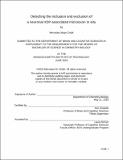| dc.contributor.advisor | Ann Graybiel. | en_US |
| dc.contributor.author | Ondik, Mercedes Maye | en_US |
| dc.contributor.other | Massachusetts Institute of Technology. Department of Biology. | en_US |
| dc.date.accessioned | 2018-09-18T15:40:14Z | |
| dc.date.available | 2018-09-18T15:40:14Z | |
| dc.date.copyright | 2018 | en_US |
| dc.date.issued | 2018 | en_US |
| dc.identifier.uri | http://hdl.handle.net/1721.1/118130 | |
| dc.description | Thesis: S.B. in Chemistry-Biology, Massachusetts Institute of Technology, Department of Brain and Cognitive Sciences, 2018. | en_US |
| dc.description | This electronic version was submitted by the student author. The certified thesis is available in the Institute Archives and Special Collections. | en_US |
| dc.description | Cataloged student-submitted from PDF version of thesis. "Submitted to the Department of Brian and Cognitive Sciences in supplement to the requirements for the degree of Bachelor of Science in Chemistry-Biology." | en_US |
| dc.description | Includes bibliographical references (pages 52-54). | en_US |
| dc.description.abstract | X-linked dystonia parkinsonism (XDP), also known as torsion dystonia type 3 (DYT3), afflicts hundreds of individuals. Under an X-linked mode of inheritance, the DYT3 haplotype occurs in Filipino populations and is of the highest frequency in the Panay Islands of the Philippines. Recently, convincing evidence has shown the causative mutation to be an insertion of the repetitive sequence SINE-VNTR-Alus (SVA). This insertion is associated with misregulation of 3' end exons in the gene TBP-associated factor 1 (TAF1). TAF1, the largest of fourteen TAF proteins, incorporates into a TATA binding complex that promotes transcription by RNA polymerase II. In a collaborative effort, singleplex BaseScope" probes as well as antibodies have been produced to target two TAF1 isoforms, canonical TAF1, C-TAF1, and neuronal TAF1, N-TAF1, separately. N-TAF1 differs from C-TAF1 by the inclusion of a two amino acid microexon, 3' to the SVA insertion, known as 34'. Here, I show that N-TAF1 expression is confined to neurons and interneurons whereas C-TAF1 is widely expressed, particularly by astrocytes, interneurons, neurons, and cells present in other organs including the heart and liver in mouse. Additionally, the antibodies produced show promise for use in human tissue. These results support the hypothesis that C-TAF1 and N-TAF1 have canonical and neuron-specific functions, respectively, and misregulation of N-TAF1 is capable of causing neuronal degeneration. Ultimately these results set the foundation for the study of C-TAF1 and N-TAF1 functions and isoform misregulation in XDP diseased tissue. Furthermore, these probes and antibodies may serve as tools for the validation of XDP models, under development, in which forthcoming XDP therapies may be tested. | en_US |
| dc.description.statementofresponsibility | by Mercedes Maye Ondik. | en_US |
| dc.format.extent | 60 pages | en_US |
| dc.language.iso | eng | en_US |
| dc.publisher | Massachusetts Institute of Technology | en_US |
| dc.rights | MIT theses are protected by copyright. They may be viewed, downloaded, or printed from this source but further reproduction or distribution in any format is prohibited without written permission. | en_US |
| dc.rights.uri | http://dspace.mit.edu/handle/1721.1/7582 | en_US |
| dc.subject | Chemistry. | en_US |
| dc.subject | Brain and Cognitive Sciences. | en_US |
| dc.subject | Biology. | en_US |
| dc.title | Detecting the inclusion and exclusion of a neuronal XDP-associated microexon in situ | en_US |
| dc.type | Thesis | en_US |
| dc.description.degree | S.B. in Chemistry-Biology | en_US |
| dc.contributor.department | Massachusetts Institute of Technology. Department of Brain and Cognitive Sciences | |
| dc.identifier.oclc | 1051211613 | en_US |
